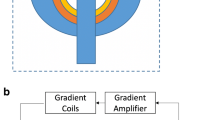Abstract
Object
To reinvestigate the dependence of the signal and contrast on sequence parameters and tissue relaxation times for intermolecular double-quantum coherence (iDQC) signals, and to explore the possibility to use a spin-echo (SE)-iDQC sequence for detecting activation signals at 3T.
Materials and methods
Brain activations were detected in five human volunteers in a visual simulation study using a SE-iDQC sequence, in addition to a GE-iDQC and a conventional single-quantum coherence (SQC) blood-oxygenation-level-dependent (BOLD) sequence. A brain phantom was also used for some quantitative measurements.
Results
By choosing an optimal echo time TE (~T2) and iDQC evolution time τ(~20 ms), robust brain activations were detected using the SE-iDQC sequence, in addition to the GE-iDQC and a conventional single-quantum coherence (SQC) BOLD sequence. A higher percentage signal change due to activation was observed for both the iDQC-based measurements in comparison to the conventional SQC acquisition.
Conclusion
Even though a phenomenological analysis consistent with the experimental results was provided, a detailed model is still needed for the contrast mechanism at microscopic level to guide potential applications of brain functional imaging based on the SE-iDQC.
Similar content being viewed by others
References
Richter W, Richter M, Warren WS, Merkle H, Andersen P, Adriany G and Ugurbil K (2000). Functional magnetic resonance imaging with intermolecular multiple-quantum coherences. Magn Res Imag 18: 489–494
Zhong J, Kwok E and Chen Z (2001). fMRI of auditory stimulation with intermolecular double-quantum coherences at 1.5T. Magn Reson Med 45: 356–364
Zhong J, Chen Z, Kwok E, Kennedy SK and You Z (2002). Optimization of BOLD sensitivity in MR imaging using intermolecular double-quantum coherence (iDQC). J Magn Reson Imag 16: 733–740
Schäfer A, Jochimsen TH and Möller HE (2005). Functional magnetic resonance imaging with intermolecular double-quantum coherences at 3T. Magn Reson Med 53: 1402–1408
Schäfer A and Moeller H (2007). Functional contrast based on intermolecular double-quantum coherences influence of the correlation distance. Magn Reson Med 58: 696–704
Warren WS, Richter W and Andreotti AH (1993). Farmer II BT generation of impossible cross-peaks between bulk water and biomolecules in solution NMR. Science 262: 2005–2009
Warren WS, Ahn S, Mescher M, Garwood M, Ugurbil K, Richter W, Rizi RR, Hopkins J and Leigh JS (1998). MR imaging contrast based on intermolecular zero-quantum coherences. Science 281: 247–251
Richter W and Warren WS (2000). Intermolecular multiple-quantum coherences in liquids. Concepts Magn Reson 12: 396–409
Ugurbil K, Hu X, Chen W, Zhu XH, Kim SG and Georgopoulos A (1999). Functional mapping in the human brain using high magnetic fields. Philos Trans R Soc Lond B Biol Sci 354(1387): 1195–1213
Marques JP and Bowtell R (2004). Optimizing the sequence parameters for double-quantum CRAZED imaging. Magn Reson Med 51: 148–157
Marques J, Bowtell R (2003) Numerical simulations of the DQC signal in inhomogeneous solutions. In: Proceedings 11th scientific meeting ISMRM, Toronto, p 1108
Majumdar S and Gore JC (1988). Study of diffusion in random-fields produced by variations in susceptibility. J Magn Reson 78: 41–55
Menon RS, Ogawa S, Tank DW and Ugurbil K (1993). 4 Tesla gradient recalled echo characteristics of photic stimulation-induced signal changes in the human primary visual cortex. Magn Reson Med 30(3): 380–6
NeuroLens software for Mac OS: freely downloaded at http://www.neurolens.org/
Duong T, Yacoub E, Adriany G, Hu X, Ugurbil K and Kim S-G (2003). Microvascular BOLD contribution at 4 and 7 T in the human brain: gradient-echo and spin-echo fMRI with suppression of blood effects. Magn Reson Med 49: 1019–1027
Gutteridge S, Ramanathan C and Bowtell R (2002). Mapping the absolute value of M0 using Dipolar field effects. Magn Reson Med 47: 871–879
Deville G, Bernier M and Delrieux JM (1979). NMR multiple echoes observed in solid 3He. Phys Rev B 19: 5666–5688
Author information
Authors and Affiliations
Corresponding author
Rights and permissions
About this article
Cite this article
Gu, T., Kennedy, S.D., Chen, Z. et al. Functional MRI at 3T using intermolecular double-quantum coherence (iDQC) with spin-echo (SE) acquisitions. Magn Reson Mater Phy 20, 255–264 (2007). https://doi.org/10.1007/s10334-007-0093-z
Received:
Revised:
Accepted:
Published:
Issue Date:
DOI: https://doi.org/10.1007/s10334-007-0093-z




